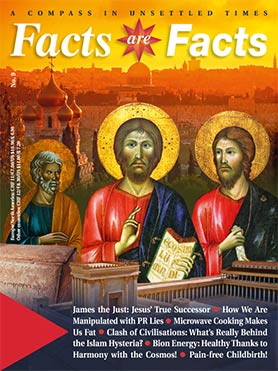Simon Peter: Built on the Wrong Rock
The Roman Church chose an extremely bad patron saint for itself: Simon Peter, who was never commissioned by Jesus to found a church.
Jesus once called this fisherman from Galilee—chosen to be a fisher of men—a “rock”. The Roman Catholic Church calls him “Christ’s representative” and thereby justifies its claim that all Christians must recognise the Pope, who sits on Peter’s throne, as the highest authority on earth. But the Vatican’s spiritual foundation is built on sand.
How Simon Became Peter

Simon Peter is usually portrayed with a key in his hand—but its symbolical meaning is misunderstood.
The Greek word for ‘rock’ is of course ‘petros’, which is why Simon was called Peter from that time on. Jesus himself spoke Aramaic and actually gave Peter the nickname ‘Cephas’, which means the same thing.
So what exactly did Peter mean that had so pleased Jesus’ heart? Did Peter really glorify him in that moment as the future saviour of all mankind and only Son of God, as Saint Paul later taught? That would have been, if you will excuse me for saying so, quite an arrogant attitude for Jesus, an attitude that better befits the Roman Popes and their claim of infallibility than the courageous messenger of God who taught the people: “I assure you: the one who believes in Me will also do the works that I do. And he will do even greater works than these” (John 14:12). And who further exhorted his listeners: “Is it not written in your law, ‘I said, you are gods’?” (John 10:34).
So if we all, according to his own words, are gods and can perform the same miracles as Jesus himself—what sense does it make to hang him on the wall as the unique, unattainable image of God? When Jesus really everlastingly washed the world clean of sin, then it follows that we too can do it. But if this is the case, then why did Jesus even need to do it in the first place?
Jesus was a normal human being. He had to have been. Only then could he justifiably have said: Look here, you can attain and accomplish what I have! If Jesus was really born of a virgin and came to the world as the only ‘begotten Son of God’, then we ordinary mortals could have retorted in good conscience, ‘Hah… he can talk. After all, he’s a god; we, on the other hand, are only weak humans!’—which is exactly what the Christians, to cut to the chase, have done for almost two thousand years.
A prophet is without honour in his own land, as the old adage goes. Moreover, many people simply don’t understand what they are being taught. Jesus knew this frustration all too well. He shared the “secret of God’s kingdom” with his disciples, but he spoke to the masses in parables because “though seeing, they may not see; though hearing, they may not understand” (Luke 8:10). Nevertheless, even his confidantes often did not understand him. “I have yet many things to say to you,” lamented Jesus to his disciples, “but you cannot bear them now” (Joh n 16:12).
When Rocks Become so-called “Living Stones”
But at that point when Jesus asked his question about the Son of Man, Simon Peter had a moment of clarity. He saw through Jesus’ person and recognised in him the ‘Christos’ (Greek) or ‘Messiah’ (Hebrew)—two words that both simply mean ‘the anointed one’. They symbolise the Christed Man who is truly ‘born again’, awakened to his inner divinity, having been transformed from an immature, ‘embryonic child of God’ to a responsible ‘Son of God’ or ‘Daughter of God’.1 Such people are truly like rocks against the breakers, steadfast and solid. Simon Peter recognised the Christ in Jesus’ eyes and Jesus believed that Peter would be able to carry his message about the Son of Man out into the world, which is why Jesus gave him the appropriate nickname ‘rock’. That’s all.
Peter was quite aware of this. He certainly didn’t see himself as predestined to be the only rock in the coming world religion. In one of his letters to the congregations he wrote: “You also, as living stones, are built up as a spiritual house [ed. Note: i.e. a church], an holy priesthood,” (1 Pet 2:5). All people who have become one with the Christ or the ‘Son of Man’ are such ‘living stones’. It is of absolutely no importance what religion they might outwardly practise, for God knows no division. This at-one-ness with the divine is the natural, intended condition of each of us, and which we have fallen out of through the negative creations of our thoughts, feelings, and deeds (symbolised by the allegory of the Fall of Adam and Eve). To once again reach that unity with God is the goal of our earthly existence. We can never know the moment when this mystical ‘second birth’ arrives for us individually. Some of us have probably already passed this moment and live our Christhood as truly ‘born again’ people in a condition of continuous inner happiness, rarely buffeted by the storms of life.
Yet Christianity affected by the Roman Church knows nothing of this. That church was much too preoccupied with trying to spin her story around the radiant, shining light of a Peter who never existed as such.
Sources
- 1 See Facts are Facts no. 6, pg 38: Rebirth vs. Reincarnation, and pg 42: the Second Coming of Christ.






